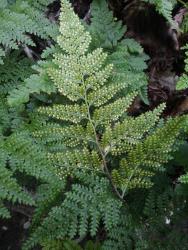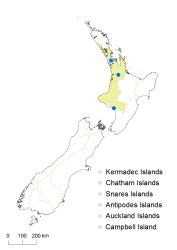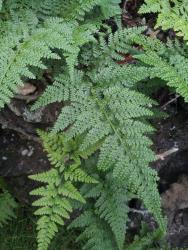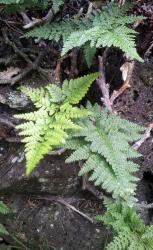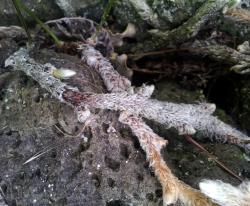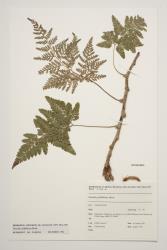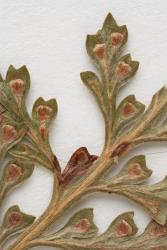- ≡ Leucostegia griffithiana (Hook.) J.Sm., Hist. Fil. 84 (1875)
- ≡ Humata griffithiana (Hook.) C.Chr., Contr. U.S. Natl. Herb. 26: 293 (1931)
Epiphytic or terrestrial ferns. Rhizomes long-creeping, up to 930 mm long (in herbarium specimens), 2–6 mm in diameter, with stipes arising 10–60 mm apart; densely scaly. Rhizome scales subulate, 6–9 mm long, 0.8–1.6 mm wide at expanded base, peltate, with pale margins and a dark centre, margins bearing setae but lacking multiseptate hairs. Fronds 95–335 mm long. Stipes 50–120 mm long, red-brown proximally, yellow-brown distally, glabrous. Rachises yellow-brown or pale brown, narrowly winged ± throughout, sulcate, glabrous. Laminae 3-pinnate or usually 3-pinnate-pinnnatifid, deltoid-pentangular or broadly ovate, tapering to a short pinnatifid apex, 45–215 mm long, 35–200 mm wide, yellow-green on both surfaces, coriaceous, glabrous; slightly dimorphic, the fertile laminae more divided and with smaller ultimate segments than the sterile. Primary pinnae in 12–20 pairs below pinnatifid apex, overlapping, narrowly winged except proximally; the distal primary pinnae pinnatifid and narrowly ovate; the proximal pair the largest, 23–110 mm long, 12–75 mm wide, broadly ovate and divided into secondary pinnae, apices acute, bases stalked. Secondary pinnae ovate, narrowly winged, decreasing markedly in length along each primary pinna to its apex; the basal basiscopic one the largest, 9–60 mm long, 4–25 mm wide, apices acute, bases stalked, divided into tertiary pinnae. Tertiary pinnae ovate or oblong, winged; the longest at or near the base of the secondary pinnae, 3–20 mm long, 1–8 mm wide, apices acute or obtuse, divided more than halfway to midrib, bases stalked. Apices of ultimate fertile lamina segments often bidentate, those of sterile segments acute or obtuse. Sori oblong, terminating veins just inside the pinna margins; indusia obovate, attached at base and ⅔–¾ of both sides forming shallow pouches, 0.8–1.7 mm long, 0.6–1.1 mm wide, apex rounded, ending at or inside the lamina margin, sometimes with a lamina tooth on the outside.
Davallia griffithiana is most easily distinguished from D. tasmanii by its rhizome scales, which lack marginal, multiseptate hairs. The fronds of the two species are generally rather similar. However, the indusia of D. griffithiana are obovate with rounded apices and attached along ⅔–¾ of both sides to form shallow pouches (Nooteboom 1994, fig. 12), whereas in D. tasmanii they are oblong, truncate at the apex and attached along all of both sides to form deep pouches (von Konrat et al. 1999, fig. 3). In D. trichomanoides, the sori are placed further from the lamina margin and protected by indusia, which are narrowly oblong, attached along all of both sides and truncate or only slightly rounded at the apices (Nooteboom 1994, fig. 30). D. griffithiana is further distinguished from D. trichomanoides by its less divided frond with broader ultimate segments.
North Island: Auckland, Taranaki.
Altitudinal range: 25–60 m.
Davallia griffithiana is naturalised in parts of Auckland city, around Hamilton, and in Whanganui.
Occurs naturally in India, Tibet, China, Japan, Taiwan, Burma, Laos and Vietnam (Nooteboom 1994).
Davallia griffithiana occurs as an escape from cultivation, growing as an epiphyte or on brick, basalt or scoria walls in old gardens, derelict sections or quarry sites.
de Lange (1987, p. 58, as D. fejeensis complex). Voucher WELT P015604, 1986.



